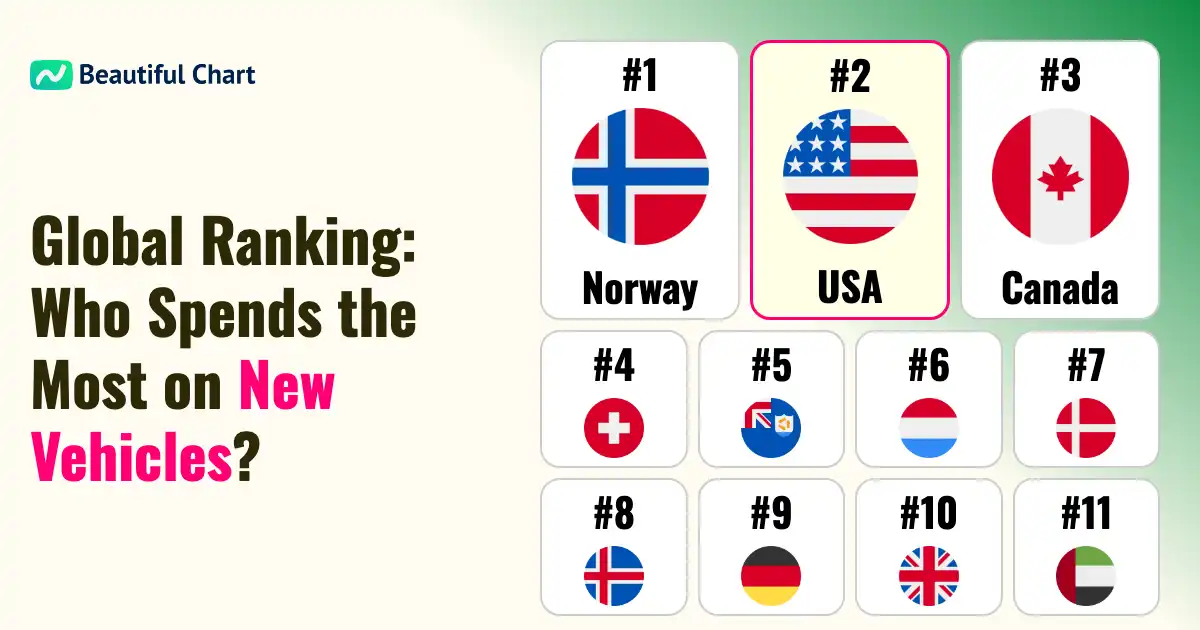
You Won't Believe How Much These Countries Spend on Cars Annually! Is Yours on the List?
- ASUMUP
- Economy
- September 20, 2025
For many, a car is far more than just a way to get from point A to point B; it's a statement, a status symbol, and a crucial part of daily life. The amount of money people are willing to shell out for a new set of wheels varies dramatically across the globe, influenced by everything from national income and tax policies to cultural values and environmental incentives. This isn't just about who buys the most expensive cars, but rather how much the average person in a country spends on car purchases each year, painting a fascinating picture of global automotive trends.
We're diving deep into the data to reveal the top 10 countries where citizens spend the most on new vehicles annually. You might expect to see certain economic powerhouses on this list, but some of the rankings could genuinely surprise you. From electric vehicle havens to nations with a deep-seated love for luxury and performance, get ready to see which countries are leading the charge in automotive spending.
Top Car Spenders REVEALED
- #1 Norway - $2281.2
- #2 USA - $1876.2
- #3 Canada - $1800.2
- #4 Switzerland - $1730.9
- #5 Anguilla - $1727.2
- #6 Luxembourg - $1517.9
- #7 Denmark - $1341.7
- #8 Iceland - $1202.8
- #9 Germany - $1127.3
- #10 UK - $1099.4
#10 UK - $1099.4
Rounding out the top 10 is the United Kingdom, which features one of the most diverse and competitive car markets in the world. British consumers have access to a vast array of brands and models, with a notable preference for premium and luxury vehicles. The prevalence of company car schemes and attractive financing options like Personal Contract Purchase (PCP) makes it easier for consumers to get into new, more expensive cars every few years, which keeps the spending cycle active. This contributes significantly to the high per capita figure.
Furthermore, the UK government has been actively promoting a shift to electric vehicles with subsidies and a planned ban on new petrol and diesel car sales, stimulating investment in this growing market segment. Despite economic uncertainties, the car remains an essential part of British life, particularly for those living outside of major urban centers. The combination of a competitive market, accessible financing, and a push towards new technologies keeps the UK firmly in the top tier of global car spenders.
#9 Germany - $1127.3
As the birthplace of the modern automobile and home to iconic brands like Volkswagen, BMW, Mercedes-Benz, and Porsche, Germany's passion for cars is world-renowned. There is a deep cultural pride in German engineering, and consumers often show strong loyalty to their domestic brands. The famous Autobahn network, with its sections of unrestricted speed limits, also cultivates a demand for powerful, high-performance vehicles that can handle high-speed travel with ease and safety. This drives spending towards more premium and technologically advanced models.
The German economy is the largest in Europe, and the automotive sector is a critical part of it, supporting millions of jobs. German consumers benefit from a highly competitive market and often have the financial means to purchase new cars regularly. This cultural appreciation for automotive excellence, combined with strong economic fundamentals, ensures Germany's place as a global leader in the industry and in per capita spending.
#8 Iceland - $1202.8
Iceland's unique and challenging geography is a major factor behind its high per capita car spending. The rugged terrain, unpredictable weather, and vast unpaved 'F-roads' make robust, capable vehicles—particularly 4x4s and SUVs—a near necessity rather than a luxury. These types of vehicles naturally command higher prices, which elevates the country's average spending. The nation's economic recovery following the 2008 financial crisis has also restored consumer confidence and purchasing power.
A booming tourism industry has further fueled the demand for new vehicles, both for rental companies and for residents who benefit from the economic upswing. Like other Nordic countries, there is also a growing interest in electric vehicles, supported by the country's abundance of renewable geothermal and hydroelectric energy. This blend of geological necessity and economic resurgence places Iceland firmly on the list of top car spenders.
#7 Denmark - $1341.7
Denmark's inclusion in the top 10 is fascinating, primarily because it is famous for having some of the highest car registration taxes in the world, which can exceed 150% of the vehicle's value. Despite this, Danes still spend a significant amount on cars, a fact that speaks to the country's high standard of living and strong economy. Consumers may be buying smaller or more modest cars than in other wealthy nations, but the crippling taxes ensure the final price paid is still very high. This paradox is a key feature of the Danish auto market.
In recent years, tax reforms aimed at encouraging greener vehicles have slightly altered purchasing habits, with a growing interest in electric and hybrid models that benefit from lower tax rates. Nonetheless, the sheer cost of acquiring a new car, whatever the model, keeps Denmark's per capita spending high. It’s a market defined not by extravagance, but by the high financial barrier to car ownership that citizens are willing and able to overcome.
#6 Luxembourg - $1517.9
As one of the wealthiest countries in the world on a per capita basis, Luxembourg's high ranking is logical. The nation boasts an incredibly high disposable income, allowing its citizens to invest heavily in new and often premium vehicles. The automotive market is also heavily influenced by favorable tax policies, particularly for company cars, which are a common perk for the country's large workforce in the financial and professional services sectors. This encourages frequent turnover and spending on higher-end models.
Luxembourg's central location in Europe and its large population of cross-border commuters also play a role, as a reliable and comfortable car is essential for many. The country’s residents have a clear penchant for prestigious German brands, which contributes to the high average expenditure. The combination of personal wealth, corporate benefits, and geographical necessity makes Luxembourg a powerhouse of car consumption.
#5 Anguilla - $1727.2
Perhaps the most surprising entry in the top 5, the small Caribbean island of Anguilla punches well above its weight in car spending. This high figure can be attributed to its status as a luxury tourist destination and an offshore financial hub, attracting a wealthy demographic of residents and expatriates. The cost of living is high, and this extends to vehicles, which are subject to significant import duties and taxes, inflating their final price tag. Consequently, the value of car purchases is disproportionately high for its small population.
Moreover, the island's tourism-driven economy requires a fleet of modern and comfortable vehicles for rentals and transportation services, contributing to the overall expenditure. While not a reflection of a mass-market car culture like the U.S. or Canada, Anguilla's spending is a clear indicator of a niche, high-value market. It's a prime example of how localized economic factors can create statistical outliers in global rankings.
#4 Switzerland - $1730.9
Switzerland's place on this list is a testament to the country's immense wealth and high purchasing power. The Swiss market shows a strong preference for premium and luxury brands, with consumers valuing quality, performance, and cutting-edge technology. It's common to see streets filled with high-end models from German manufacturers like BMW, Mercedes-Benz, and Audi, which naturally drives up the average spending per person. The nation's pristine road infrastructure and scenic driving routes also encourage an appreciation for fine automobiles.
In Switzerland, a car is often seen as a reflection of personal success and status, and consumers are willing to pay a premium for it. The country's stable, high-income economy means that a significant portion of the population can afford to purchase new, expensive vehicles on a regular basis. This focus on the high-end segment of the market ensures that Switzerland maintains its position as one of the world's top per-capita spenders on cars.
#3 Canada - $1800.2
Just behind its southern neighbor, Canada's high ranking reflects a similar car-dependent culture shaped by vast distances and suburban living. Canadian consumers often prioritize practicality and durability, with a strong demand for all-wheel-drive vehicles, SUVs, and trucks capable of handling harsh winter conditions. While taxes and fuel costs are generally higher than in the U.S., a stable economy and high standard of living support robust vehicle sales. The automotive market is a cornerstone of the Canadian retail economy.
Furthermore, Canadian consumer preferences mirror many trends seen in the U.S., including a growing interest in larger, more versatile vehicles. The need for a reliable car is a non-negotiable for many families, leading them to invest a significant portion of their income into their vehicles. This blend of necessity, challenging climate, and economic stability solidifies Canada's position as a top spender in the automotive world.
#2 USA - $1876.2
It's no surprise to see the United States ranking high on this list, a nation with a deeply ingrained car culture. The American dream is often intertwined with the open road, and that translates to significant spending on vehicles, particularly large SUVs and pickup trucks that dominate the sales charts. Relatively low fuel prices and vehicle taxes compared to European nations make owning and operating larger, more expensive cars more feasible for the average consumer. The sheer size of the country and the reliance on personal vehicles for transportation in most areas further fuel this high level of expenditure.
American consumers also have access to a vast and competitive market, with domestic and foreign brands vying for their attention through aggressive financing deals and frequent model updates. This cycle of consumption, combined with a cultural affinity for size, power, and the latest technology, ensures that the U.S. remains a global heavyweight in automotive spending. From daily commutes to cross-country road trips, the car is an essential and expensive part of American life.
#1 Norway - $2281.2
Taking the undisputed top spot is Norway, where the average person spends over $2,200 a year on new cars. This impressive figure is largely driven by the country's aggressive and highly successful push towards electric vehicles (EVs). The Norwegian government offers substantial incentives, including tax exemptions and perks like access to bus lanes, making EVs an incredibly attractive option for consumers despite the country's high cost of living. This forward-thinking policy has reshaped the nation's automotive landscape, making it a global leader in sustainable transportation.
Furthermore, high disposable incomes combined with a strong environmental consciousness mean Norwegians are both willing and able to invest in newer, greener technology. The government's goal to phase out the sale of new fossil-fuel cars by 2025 has accelerated this trend, pushing annual spending to heights unseen anywhere else. It’s a perfect storm of wealth, policy, and cultural mindset that places Norway firmly in pole position.
Other Posts in the Economy
Categories
- National Rankings(43)
- Science & Technology(1)
- Sports(24)
- Economy(30)
- Society(12)
- Culture(7)
Recent Posts
![Bayern Spent HOW MUCH on Harry Kane?! Ranking Their Top 10 Biggest Signings Ever]() A deep dive into Bayern Munich's ten most expensive transfers, exploring how the club's spending strategy has evolved to chase European glory.
A deep dive into Bayern Munich's ten most expensive transfers, exploring how the club's spending strategy has evolved to chase European glory.![Arsenal's Record-Shattering Spree: From a €116M Gamble to a Flop, Who Was Worth the Cash?]() A deep dive into Arsenal's top 10 most expensive signings, analyzing the successes, the failures, and the massive fees that have defined the club's modern transfer strategy.
A deep dive into Arsenal's top 10 most expensive signings, analyzing the successes, the failures, and the massive fees that have defined the club's modern transfer strategy.![Chelsea Cashes In BIG TIME! Who Really Won the 25/26 Summer Transfer Window Money Game?]() A deep dive into the top 10 clubs that made the most money from player sales during the wild 25/26 summer transfer window.
A deep dive into the top 10 clubs that made the most money from player sales during the wild 25/26 summer transfer window.![Liverpool's Record-Breaking €483M Spree! Did They Just Buy the Premier League Title?]() A deep dive into the 25/26 summer transfer window reveals Liverpool's record-breaking spending spree as Premier League clubs continue to dominate the market.
A deep dive into the 25/26 summer transfer window reveals Liverpool's record-breaking spending spree as Premier League clubs continue to dominate the market.![You Won't Believe How Much a Loaf of Bread Costs in These Countries! (Spoiler: It's INSANE)]() This post explores the top 10 countries with the most expensive bread, revealing how factors like import reliance and tourism dramatically inflate the cost of this basic staple.
This post explores the top 10 countries with the most expensive bread, revealing how factors like import reliance and tourism dramatically inflate the cost of this basic staple.
















